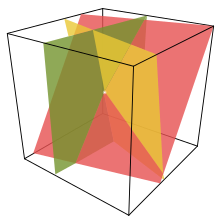This article includes a list of general references, but it lacks sufficient corresponding inline citations. (October 2015) |

In mathematics, a system of linear equations (or linear system) is a collection of two or more linear equations involving the same variables.[1][2] For example,
is a system of three equations in the three variables x, y, z. A solution to a linear system is an assignment of values to the variables such that all the equations are simultaneously satisfied. In the example above, a solution is given by the ordered triple since it makes all three equations valid.
Linear systems are a fundamental part of linear algebra, a subject used in most modern mathematics. Computational algorithms for finding the solutions are an important part of numerical linear algebra, and play a prominent role in engineering, physics, chemistry, computer science, and economics. A system of non-linear equations can often be approximated by a linear system (see linearization), a helpful technique when making a mathematical model or computer simulation of a relatively complex system.
Very often, and in this article, the coefficients and solutions of the equations are constrained to be real or complex numbers, but the theory and algorithms apply to coefficients and solutions in any field. For other algebraic structures, other theories have been developed. For coefficients and solutions in an integral domain, such as the ring of integers, see Linear equation over a ring. For coefficients and solutions that are polynomials, see Gröbner basis. For finding the "best" integer solutions among many, see Integer linear programming. For an example of a more exotic structure to which linear algebra can be applied, see Tropical geometry.
- ^ Anton (1987), p. 2; Burden & Faires (1993), p. 324; Golub & Van Loan (1996), p. 87; Harper (1976), p. 57.
- ^ "System of Equations". Britannica. Retrieved August 26, 2024.

